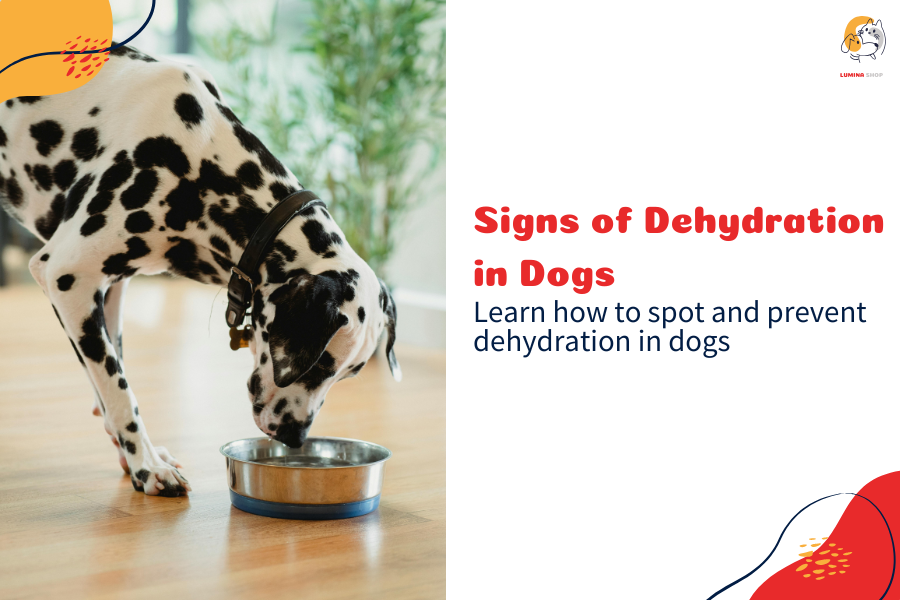
What Are the Signs of Dehydration in Dogs?
Dehydration is a serious and potentially dangerous condition that can affect dogs of all breeds and ages. Since water is essential for nearly all bodily functions, even mild dehydration can lead to health concerns. As a responsible pet owner, identifying dehydration early can help prevent complications and keep your furry companion healthy and happy.

Why Is Hydration Important for Dogs? | The Importance of Hydration in Canine Health
Proper hydration is crucial for your dog's overall well-being. Water plays a key role in:
• Regulating body temperature – Preventing overheating, especially in hot weather.
• Aiding digestion – Helping with proper digestion and nutrient absorption.
• Lubricating joints – Supporting mobility and reducing discomfort.
• Eliminating toxins – Ensuring proper kidney and liver function.
Since dogs lose fluids throughout the day—mainly through panting, urination, and activity—it’s essential to provide them with enough water to stay hydrated.

Common Signs of Dehydration in Dogs | How to Recognize Dehydration Symptoms
Detecting dehydration early can help prevent serious health issues. Here are the key signs to look out for:
1. Loss of Skin Elasticity
One of the simplest ways to check for dehydration in dogs is the skin tent test. Gently pinch the skin on the back of your dog’s neck or between the shoulder blades. If the skin quickly snaps back into place, your dog is well-hydrated. If it takes longer or stays tented, dehydration could be a concern.
2. Dry or Sticky Gums
Healthy dog gums should be smooth and moist. If your dog’s gums feel dry, sticky, or tacky, it may indicate dehydration. Additionally, pale or discolored gums could signal more serious health concerns.
3. Excessive Panting and Thick Saliva
Panting is normal, but if your dog is excessively panting without physical exertion or heat exposure, it may be dehydrated. Dehydrated dogs may also have thick, sticky saliva instead of normal drool.
4. Lethargy and Weakness
If your dog seems overly tired, sluggish, or uninterested in play, dehydration could be the cause. Well-hydrated dogs are generally more active and responsive to their surroundings.
5. Loss of Appetite
Dehydrated dogs may refuse food or eat significantly less than usual. Since water is essential for digestion, dehydration can cause discomfort, further reducing their appetite.
6. Sunken Eyes and Dry Nose
If your dog’s eyes appear dull, sunken, or dry, it may be dehydrated. A dry or cracked nose can also be a sign that your dog needs more water.
7. Dark or Decreased Urine Output
Hydrated dogs produce light yellow urine regularly. If your dog’s urine is darker in color or less frequent, it may be dehydrated.

What Causes Dehydration in Dogs? | Dehydration Causes and Risk Factors
Dehydration in dogs can occur due to several factors, including:
• Insufficient water intake – Lack of access to fresh water or reduced thirst due to illness.
• Excessive heat exposure – Dogs can quickly become dehydrated in hot weather or after strenuous activity.
• Illness or vomiting/diarrhea – Frequent vomiting or diarrhea can lead to rapid fluid loss.
• Underlying medical conditions – Conditions such as kidney disease, diabetes, or infections can increase the risk of dehydration.

How to Keep Your Dog Hydrated | Tips for Preventing Dehydration
Preventing dehydration is much easier than treating it. Here are some simple ways to ensure your dog stays hydrated:
• Provide constant access to fresh water – Always make sure your dog has access to clean, fresh water.
• Incorporate moisture-rich food – Wet food can help increase hydration levels in your dog’s diet.
• Encourage drinking – Some dogs prefer drinking from a pet water fountain, making hydration more appealing.
• Use electrolyte supplements – If your dog is mildly dehydrated, vet-approved electrolyte solutions can help restore hydration levels.
• Monitor hydration levels – Regularly check your dog’s skin elasticity, behavior, and urination habits.

Related Hydration Products for Dogs | Recommended Hydration Products
To help keep your dog properly hydrated, check out these hydration-related products from Lumina Pet Shop:
🦴 Portable Water Bowls – Perfect for walks, hikes, and outdoor adventures.
💧 Electrolyte Supplements for Dogs – Boost hydration, especially in hot weather or illness.
🍖 Moist Dog Food – A great way to add extra hydration to your dog’s meals.

Conclusion | Prevent Dehydration in Dogs with Proper Hydration
Dehydration in dogs is a serious issue, but it’s easy to prevent with proper care. Ensure your dog has constant access to fresh water, provide moisture-rich food, and watch for signs of dehydration. By following these tips and using the right products, you can keep your furry friend hydrated and healthy. Visit Lumina Pet Shop for more hydration-related products to support your dog’s well-being.
